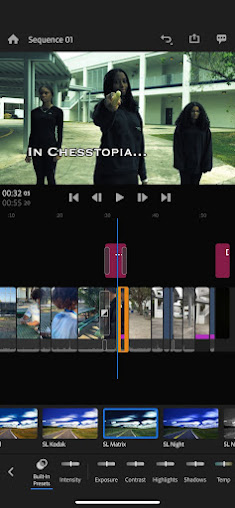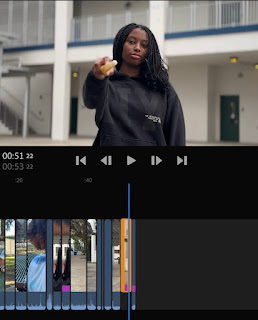Creative Critical Reflection
Creative Critical Reflection
2. How does your product engage with audiences and how would it be distributed as a real media text?
If my film was distributed as a real media text, marketing would go a little like this. First, we would make advertisements like trailers and movie posters. Those will then be advertised in local public areas that our demographic, teens and older, frequently visit. We would most likely do most of the marketing on big social media platforms, like TikTok, Instagram and Twitter. We will record data of the times that content is mostly consumed throughout the day and week, that way we can determine around what time we would get the most views for our ads. Additionally, we will keep track on current trends and publish relatable content a that regards our film to get people excited about our film. As a teenager who frequently uses social media, I have seen that other people, especially in my age group, get intrigued about anything if it is aware and taking part in trends usually done by ordinary people. We can also publish the entire film on TikTok as it allows you to publish videos as long as an hour. We would most likely distribute it to a media streaming company like Netflix, Hulu, or HBO max etc.
3. How did your production skills develop throughout this project?
4. How did you integrate technologies - software, hardware and online - in this project.
Post-Production: wrapping up!
Post-Production: Wrapping up!
We were met with another issue during editing, our final scene that is the "winning scene" would glitch at random times, whether it would glitch in adobe rush or after being exported. We tried restarting the app, taking the clip out and putting it back in, and even restarted the device but somehow it would still glitch. This was a big issue because the "winning scene" represents the Black Queen or villainess conquering in Chesstopia, and it also shows that the game has concluded. We also tried very hard to achieve the scene so it holds plenty of value. Fortunately, we had a second take of that scene that basically showed the same thing, except it is less dramatic than the first take which was the better one. Oh well beggars cannot be choosers, so in order to keep the "winning scene" included in the film, we had to use the second shot that actually worked.
Besides that, sound designing was completed today, the final day of post-production. All we had to do is fix up audio placement as most of the work was done by the sound designer by herself the previous day. Everything came out smoothly and we were able to finish before the deadline. I am very proud of my team for working hard, and having our work payed off in the end. I am excited to see everyone's film and excited to see what our classmates think of ours.
Post-Production: Achieving horror/thriller
Post-Production: Achieving horror/thriller
If you have read my previous blog "attempting to achieve horror/thriller", you would know that my crew and I struggle to get the idea of horror/thriller in our film because certain important shots were on the brink of getting cut out. Fortunately, today my editor and I had the time to re-access this issue. In order to have enough time for both shots (the villainess staring into the camera & the villainess walking towards the camera) we had to remove another shot that was deemed less valuable. Luckily for us, we only had to remove one shot that we were able to replace without effecting our time.
The shot we removed, also discussed in the "redundant shots" blog
More about this shot and why we removed it is discussed in my previous blog, "redundant shots"
Now that the two shots can exist in our film, we were able to reorganize the shots following after, reordering the "winning" scene from the end of the "playing chess" scene to the end of our whole film. By doing this we were able to allow the viewer to understand how the Queen strategically moves both in the fantasy world, Chesstopia, and the real world as a chess piece. My editor was able to do a smooth transition between both scenes, making it seem like the Queen or villainess moving towards the camera was the same thing as player 1 moving her queen, capturing the opponents queen, and winning the game. This provides a jump from fantasy to reality.
The "winning" scene
Additionally, by using lighting altering filters, we made the environment of the fantasy world, Chesstopia, seem gloomy, dark and rigid, almost like the air quality was stifle and poor. I desired for this look because it strongly reminds me of a dystopian world and that's exactly what I wanted for our film. We also made the look stand out by making the real world with the two players, have normal and bright lighting. This shows a jump from reality and dystopian, and makes it more obvious that we switched worlds without looking at the establishing shot.
A screenshot of the filter we used to add gloom to the environment
Finally, we depend on the sound designer to add sounds that pull the horror/thriller genre together, like a bow on a wrapped present. We will continue to be in touch and refer to the script and figure out what shot should have what audio.
a screenshot of our script
Post-Production: the "zoom shot"
Post-Production: The "zoom shot"
The "zoom shot", originally a shot that was discarded in our first evaluation, quickly became an important shot in the "playing chess" scene.
The "zoom shot" in the "playing chess" Scene
During our first rough draft we realized that we were over the limit and believed that many of the shots in the first few scenes were redundant, showing almost the same thing. When we were going through what shots we should cut from the film, we were confident that the "zoom shot" of the "playing chess" scene was unnecessary and did not prove much value to the scene compared to the other shots.
However, after meeting for the second time during post-production, we noticed that it does have a good purpose in the scene. Therefore, we placed it back in the film but instead of its original spot, we placed it at the end of the "playing chess" scene, utilizing it as a transition from the "playing chess" scene and the "queen's command" scene. After doing this, it set a path for us to easily figuring out what other shots are less valuable and throughout the entirety of the film.
Post-Production: redundant shots
Post-Production: redundant shots
Many of our shots are quite redundant, facing us with another issue, figuring out which shot is more valuable than the other. My editor and I are together, sharing ideas and working through the entire clip, basically reconstructing our previous draft. We found out that removing some shots actual made the scene more meaningful and easier to understand.
For instance, we had a shot where it was a close up on player 2 and her facial expressions portrays confidence.
At first I thought that this was a very important shot for the "playing chess" scene because it tells the audience that she has came up with a good plan to potentially help her win against her opponent. However, after much consideration we realized that without the shot, the scene actually went smoother rather than feeling cluttered. To ensure that the point is still being put across we asked a classmate what their first thought of the section was. We received feedback with them saying that it seems like player 2 thought she would win but in the end she did not. It is important that we are still providing the same message even when cutting certain shots out.
Post-Production: Attempting to achieve Horror/Thriller
Post-Production: Attempting to achieve Horror/Thriller
During Post-production, my group mates and I came across a problem with our shots, with all the shots that we took taken into consideration the film was 1 minute and 45 seconds. This is a big issue because the limit is 1 minute, everything after will not be taken credit for. To solve this we had to decide what takes we need to cut completely from the film to shorten time. Unfortunately, this negatively impacts our film as certain shots work together to portray a thriller genre. For instance, the shot where we create suspense by focusing on the villainess will not give the same energy if the following shot, where the villainess is walking towards the camera, be removed completely. A lot of our shots in these scenes work together to get the point across, therefore, without one shot, the whole scene is thrown off and would confuse the viewer. I hope that during our next time of meeting my groupmates and I are able to access this issue. I want to suggest taking time to cut down excess breathing and pausing in the takes, rather than removing important shots such as these, to my editor. As the director I need to get one-on-one with my editor to ensure that they are not on their own making these decisions. Although its their job to edit and not mine, I still feel the responsibility to chime in to ensure that the issues will be resolved efficiently.
A screenshot of the villainess staring at the camera to create suspense
Other than that, editing the lighting and decisions from our sound designer should hopefully carry us to our goal of thriller/horror. I will be in constant communication with my sound designer making sure that the more effective sounds are being chosen, however I have much faith in my sound designer and I trust her judgment.
-
Hello world!! This is Enilrahsspace or Enilrah's Space. I am Enilrah ofcourse and this is my blog space, a place of comfort. ...
-
Pre-Prodcution: Finalizing my part During this process I was able to organize all the documents from my crew and configure a production por...







